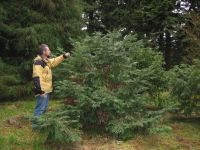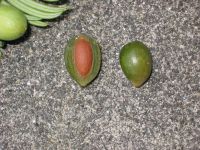Fortune plum yew - Cephalotaxus fortunei
English name:
Fortune plum yew
Scientific name:
Cephalotaxus fortunei
Family:
Cephalotaxaceae (Plum yews)
Height:
10 - 15 M
Flowering:
Spring
Range:
Central and south China, Burma
 |
 |
The plant in the photograph can be found by the Arboretums main road in square 1215 position 2017.
Plant description:
Can one grow plums on a yew? Yes, if one has a plum yew in the garden.
(Even though a related species is edible, we do not recommend that one eats the "plums" or seeds from this species without further information).
The genus Cephalotaxus belongs to the Plum yew family which has a natural range as an under-story tree in forests in East Asia from the Himalayas through China to Japan and south to the Malay peninsula. The genus Cephalotaxus is reported to comprise 10 species plus 2 varieties. However, the number of species in this genus is debated, a good indication that in the science of Taxonomy a plant name is not fixed but is taken to be a hypothesis to be tested in as many ways as possible. The name of the genus means, head yew and derives from the male catkins which are organised in round heads. The plants are monoecious, that is they occur separately as male plants or female plants.
Cephalotaxus fortunei is a large evergreen bush or a small evergreen tree that is reported to be up to 15 meters tall. Of all the plum yew species this species has the longest needles. The needles sit in two ranks on either side of the shoots. They are up to 13 cm long and 0.5 cm wide. Several plants with extra long needles have been given cultivar names, including Grandis which is a female clone and Longifolia which is a male clone.
Male cones sit in the leaf axels of the previous years shoots while the female cones sit at the base of the current years shoots. It takes two years for the plum-like arils (fruit) to ripen fully
The arils (fruit) are 2.5 cm long and elliptic ovoid. They become purple-brown on ripening. This year the seed set was large. It was so large that one branch was torn off the bush by the weight of the arils.
The Arboretums 2 m tall example stands near the main drive in our collection of East-Asian conifers. The seed producing the trees was collected in China and was a present from the Botanical Institute in Nanking in 1977.
